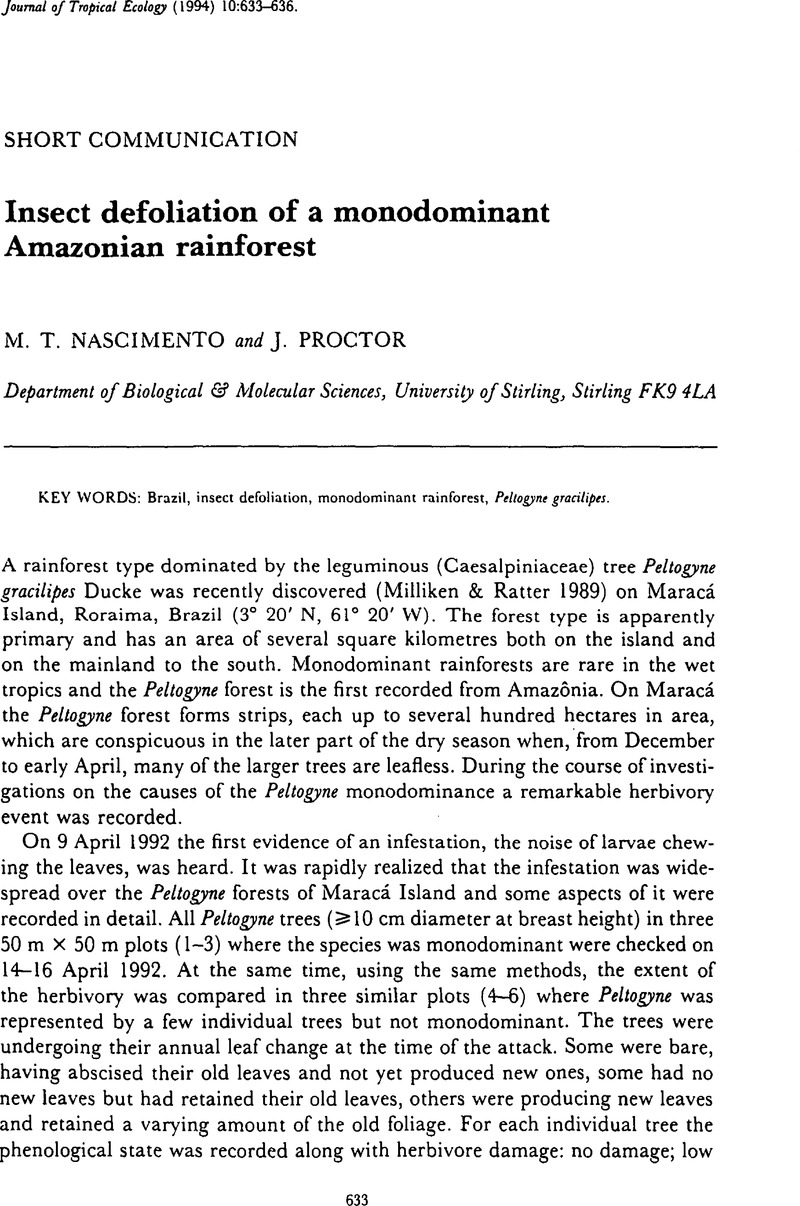Crossref Citations
This article has been cited by the following publications. This list is generated based on data provided by Crossref.
Nascimento, M. T.
and
Hay, J. D.
1994.
The impact of simulated folivory on juveniles ofMetrodorea pubescens(Rutaceae) in a gallery forest near Brasília, Federal District, Brazil.
Journal of Tropical Ecology,
Vol. 10,
Issue. 4,
p.
611.
Nascimento, Marcelo T.
and
Proctor, John
1996.
Seed attack by beetles and leaf-cutter ants on Peltogyne gracilipes Ducke (Caesalpiniaceae) on Maracá Island, Brazilian Amazonia.
Journal of Tropical Ecology,
Vol. 12,
Issue. 5,
p.
723.
Nascimento, Marcelo T.
and
Proctor, John
1997.
Population dynamics of five tree species in a monodominant Peltogyne forest and two other forest types on Maracá Island, Roraima, Brazil.
Forest Ecology and Management,
Vol. 94,
Issue. 1-3,
p.
115.
Coley, Phyllis D.
1998.
Potential Impacts of Climate Change on Tropical Forest Ecosystems.
p.
315.
Villela, Dora M.
and
Proctor, John
1999.
Litterfall Mass, Chemistry, and Nutrient Retranslocation in a Monodominant Forest on Maracá Island, Roraima, Brazil1.
Biotropica,
Vol. 31,
Issue. 2,
p.
198.
Gross, Nicole D.
Torti, Sylvia D.
Feener, Donald H.
and
Coley, Phyllis D.
2000.
Monodominance in an African Rain Forest: Is Reduced Herbivory Important?1.
Biotropica,
Vol. 32,
Issue. 3,
p.
430.
Gross, Nicole D.
Torti, Sylvia D.
Feener, Donald H.
and
Coley, Phyllis D.
2000.
Monodominance in an African Rain Forest: Is Reduced Herbivory Important?1.
BIOTROPICA,
Vol. 32,
Issue. 3,
p.
430.
Marquis, Robert J.
2005.
Biotic Interactions in the Tropics.
p.
328.
Carson, W. P.
Cronin, J. Patrick
and
Long, Z. T.
2008.
Insects and Ecosystem Function.
Vol. 173,
Issue. ,
p.
193.
Haugaasen, Torbjørn
2009.
A Lepidopteran defoliator attack on Brazil nut trees (Bertholletia excelsa) in Central Amazonia, Brazil.
Biotropica,
Vol. 41,
Issue. 3,
p.
275.
Dyer, Lee A.
Carson, Walter P.
and
Leigh, Egbert G.
2012.
Insect Outbreaks Revisited.
p.
219.
Bueno, ML.
Damasceno-Junior, GA.
Pott, A.
Pontara, V.
Seleme, EP.
Fava, WS.
Salomão, AKD.
and
Ratter, JA.
2014.
Structure of arboreal and herbaceous strata in a neotropical seasonally flooded monodominant savanna of Tabebuia aurea.
Brazilian Journal of Biology,
Vol. 74,
Issue. 2,
p.
325.
Marimon, B. S.
Felfili, J. M.
Marimon, B. H.
Fagg, C. W.
da Silveira Anacleto, T. C.
Umetsu, R. K.
Lenza, E.
Batista, J. D.
and
Rossete, A. N.
2016.
Leaf herbivory and monodominance in a Cerrado–Amazonia transitional forest, Mato Grosso, Brazil.
Plant Biosystems - An International Journal Dealing with all Aspects of Plant Biology,
Vol. 150,
Issue. 1,
p.
124.
Thomas, Sean C.
2023.
Forest Entomology and Pathology.
p.
205.
Norghauer, Julian M.
Newbery, David M.
and
Neba, Godlove A.
2023.
Indications of an Achaea sp. caterpillar outbreak disrupting fruiting of an ectomycorrhizal tropical tree in Central African rainforest.
Plant Ecology and Evolution,
Vol. 156,
Issue. 1,
p.
47.



